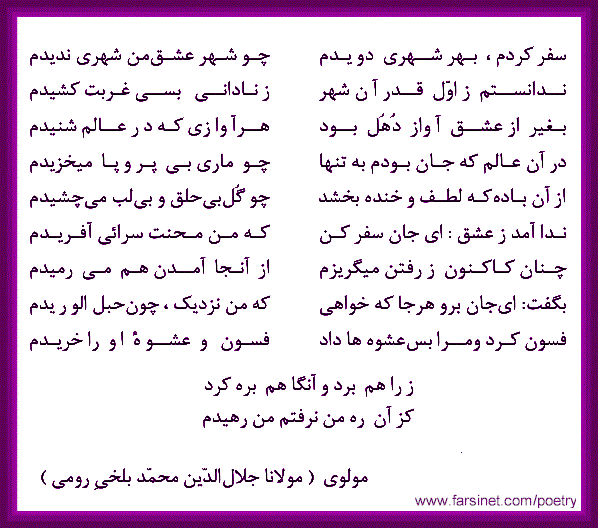

I watched the talk, I am an Iranian who is interested in mysticism and in particular Rumi and his works and I have been studying his works meticulously in order to get to the core of his teachings. This entry was posted in Rumi, The Spiritual Path, Video by Doug Marman. This meaning is hidden to outsiders, but it reveals itself to any who see the YOU in life. How appropriate that Rumi would use this same lens to fill his poetry with meaning. Love is the invisible element that draws us together with others and fills the space between us and others with meaning. Rumi’s teaching has often been called “the Sufi Path of Love.” This makes sense if he is teaching the importance of second-person perception, because love is the key to relationships, especially when it comes to our relationship with life itself. Farzad explains these principles in the video, along with a number of examples from the poems we have recently translated. These three principles keep showing up again and again in the poems we have worked on. A shared personal space opens up between us and others when we form a relationship, and this relational space between us seems to be alive with ever-changing possibilities.įrom the use of this simple lens, we found three principles that have guided us in helping to reveal the hidden meaning in Rumi’s poems. The shared experience of a relationship is not something that belongs to us as individuals it always exists between us and those we care about. This is how we learn to relate to another person, by seeing the YOU in them. Second-person perception is what we use when we are deeply involved in personal relationships.
SHAMS TABRIZI POEMS IN FARSI AND ENGLISH HOW TO
What we have found, on the other hand, is that the picture changes as soon as we use second-person lenses instead.Īfter seeing how much better second-person lenses reveal the deeper meaning in Rumi’s poetry, we’ve come to the conclusion that this is perhaps the most important element that Rumi is trying to teach: How to use second-person lenses to understand the spiritual path and spiritual experiences. While most academic translations have focused on using a third-person lens to interpret Rumi’s poetry, the end result is that they have found it difficult to see any clear evidence of a teaching in Rumi’s writings. The most important key in understanding Rumi’s poetry is related to what I have written about in my book, Lenses of Perception. After finishing more than 20 poems from Rumi’s famous Divan-i-Shams-i-Tabriz, we found three insights that have helped us with understanding Rumi’s poetry.

Each time it has surprised us to see the meaning that emerges. In each poem, our approach has revealed a hidden meaning that was not seen through a traditional interpretation. You can watch the talk below:įarzad, Mitra and I have been translating Rumi’s poems using the same approach that I learned when translating Rumi’s discourses, combined with Farzad and Mitra’s deep understanding of the Farsi language. It offers new insights into how to understand the hidden meaning in Rumi’s poetry and discourses.

Understanding a Deeper Meaning of Rumi’s Writings By Doug Marmanįarzad Khalvati gave a talk at the University of Toronto, based on a topic that he, Mitra Shafaei and I have been working on together.


 0 kommentar(er)
0 kommentar(er)
